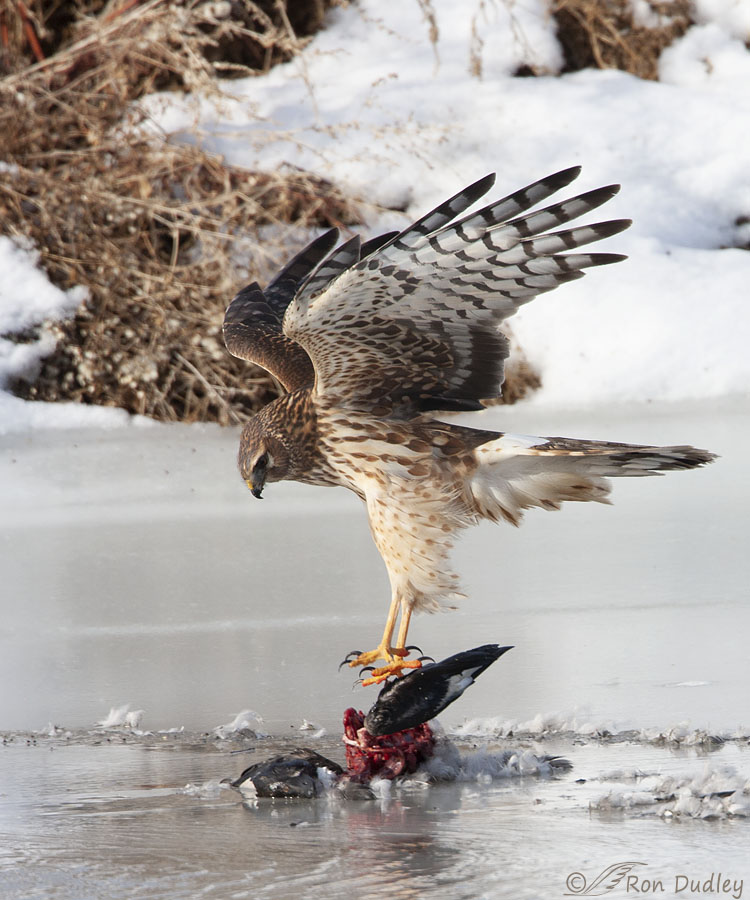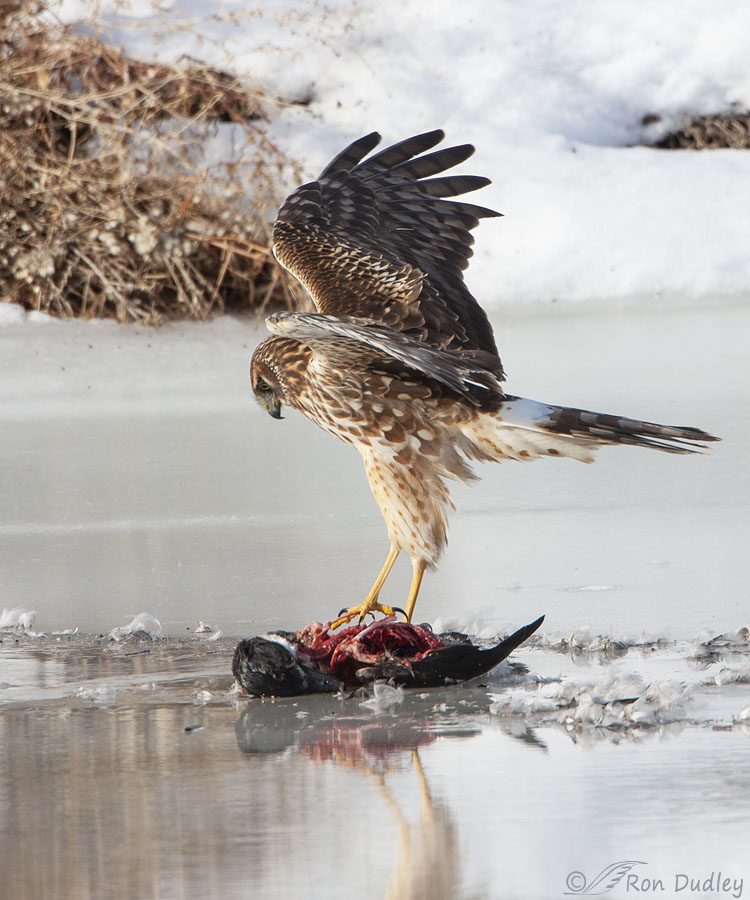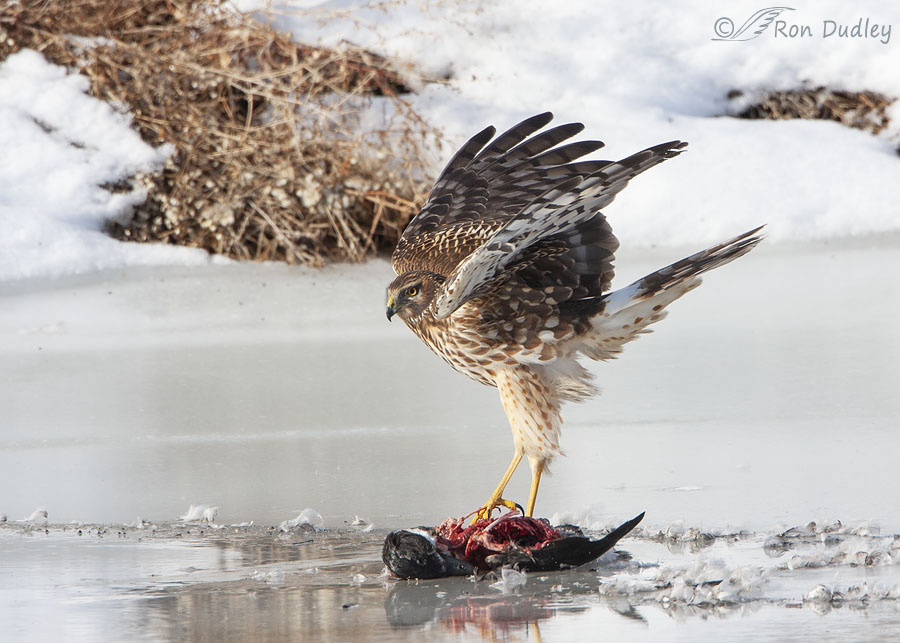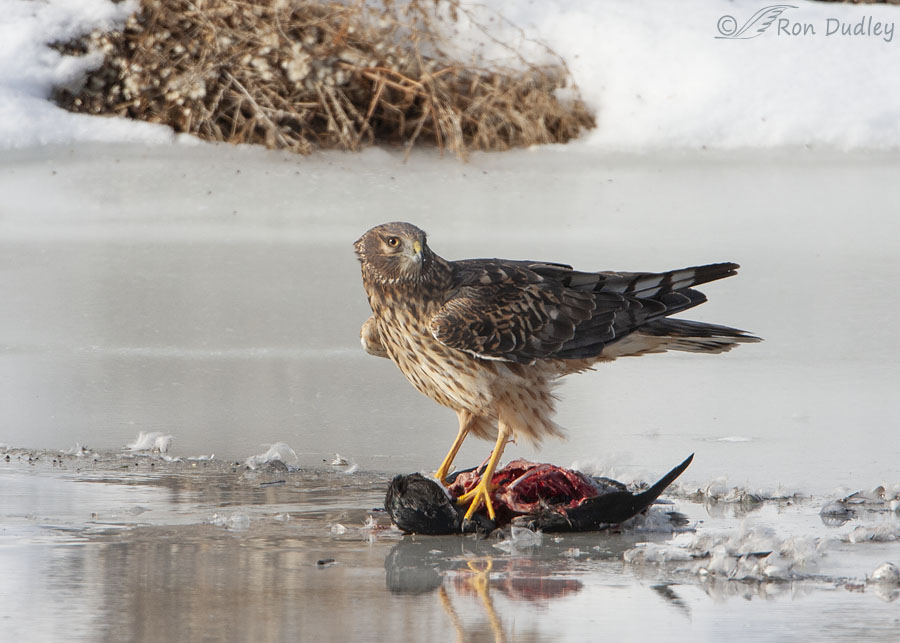VTOL (vertical takeoff and landing) aircraft have nothing on this hawk.
- This harrier series is another “gem” I discovered in some of my oldest archives at the same time I found my recent “Male American Kestrel In Hoarfrost” photo. The series was taken at Farmington Bay WMA on the morning of January 4, 2008 so it’s slightly more than 12 years old. I was using one of my first DSLR cameras, Canon’s 40D.

1/800, f/8, ISO 400, Canon 40D, Canon EF 500mm f/4L IS USM + EF 1.4 III Extender, not baited, set up or called in
On that morning I found this duck frozen into the ice. Apparently it had died or been killed in open water the night before and then became frozen in new ice during the frigid night. A moderate wind (more than just a breeze) blowing from the south, the viewer’s left, became a significant player in what I witnessed. Damn it was cold in that wind!
Northern Harriers often eat carrion during harsh winters and this one wanted frozen duck for breakfast but in the wind the hawk’s method for landing on it was rather unique. It flew to a spot about 2′ directly above the duck and then slowly, very slowly, descended vertically to it without flapping its wings. There was no flapping at all, the wind provided all the lift that was necessary. The hawk’s stiff, straight legs are one evidence of the slow, vertical descent.
But my presence may have made the bird nervous because it only stayed on the duck for a very short time before spreading its wings and lifting off (once again without flapping, using the wind for lift). But the harrier was hungry so it circled around a time or two and then came back again.

1/640, f/8, ISO 400, Canon 40D, Canon EF 500mm f/4L IS USM + EF 1.4 III Extender, not baited, set up or called in
This is the harrier’s second slow vertical landing on the duck less than a minute later.

1/640, f/8, ISO 400, Canon 40D, Canon EF 500mm f/4L IS USM + EF 1.4 III Extender, not baited, set up or called in
After touchdown in the wind it slowly folded its wings and then…
1/800, f/8, ISO 400, Canon 40D, Canon EF 500mm f/4L IS USM + EF 1.4 III Extender, not baited, set up or called in
began to feed on the duck. It was a lot of work to get the frozen meat off of the carcass but during harsh winters every morsel counts.
The harrier actually lifted off of the duck and flew back to it at least one more time. But this was in the early days of my bird photography and very soon after I’d purchased my first 500mm lens so my photography skills were primitive at best and I didn’t know my new lens very well. As a result I botched many opportunities for interesting and even unique photos as the hawk descended vertically and very slowly on the duck.
I’d give my shutter finger for another crack at it. I believe the results would be very different today.
Ron
- About my image techs: Very soon after I bought my first 500mm lens I read somewhere online that the “sweet spot” for sharpness with my lens was f/8 so that was the aperture I used for nearly all of my photography. Obviously that was a stupid move. In this situation f/8 gave me very slow shutter speeds, especially for birds. The only reason these photos are sharp (except for the first one which is a little soft) is that the harrier was descending on the duck slowly and not flapping its wings. The epitome of “dumb luck”…
- I guess I’m getting slow in my old age. I didn’t even notice that the first three photos in the series need rotation to level until after I’d published the post. Oh well, too late now.



Spectacular series Ron!!!
Charlotte
Very nice find. Sharp and nice light despite the feelings of errors.
Thank you, April.
Nice series and I welcome your “babble”.
” I welcome your “babble””
Good. Can’t believe I missed that rotation though…
This Harrier has apparently not read the Migratory Bird Treaty Act. Good that you caught him red-handed ( ok, clawed). Looks like cooold-blooded murder. This guy needs to be put on ice. I know, so do my bad jokes.
Seriously, great photos and description. Makes me wonder what other older gems you have waiting in the wings
Thanks, Lyle. I’m sure there’s still some undiscovered gems in there but I’m whittling them down, especially with all the bad weather we’ve been having.
Ron, please don’t give away your shutter finger! The last in this serious is excellent and very, very pleasing, unless one is turned off by gore. The look on the bird’s face is priceless.
I’m pretty fond of that finger, Nancy. That tells you how badly I’d like another go at it!
Amazing shots of even more amazing behavior! I’m hopeful this bird’s skill and tenacity enabled it to live a full life.
(And I didn’t notice any leveling issues until you blabbed. )
)
Thanks, Marty. I have a habit of blabbing, don’t I.
Marty continues her unhygenic habit of taking the words from my mouth. (I have cleaned my teeth though.)
On the fire front: smoke in the house again/still. Fires relatively near out of control. And a Prime Minister who says that policies to address climage change (lacking in his guvermint) will evolve. And evolve is probably the right word considering the urgency he assigns to the issue.
Yeah, I’ve seen some stuff on your PM. I’d trade our current resident of the White House for him but I wouldn’t be getting a much better deal and that’s saying something.
ScoMo is sometimes referred to as Trump-lite. And the lightness is not of his choice.
Seems to me like a pretty good name for him. But then what do I know about an Aussie PM.
Super photos Ron. I agree with Pam that this is a young Harrier. Looks much different than the mature female that I follow at one of our lakes here. And I am borrowing Judy’s “primitive by your standards”, but sensational by my standards. Life span of a Harrier is about 12 years so although not probable, it is possible that this youngster might still be around.
“it is possible that this youngster might still be around”
I never thought of that possibility, Everett. I sure hope so.
Enjoyable series. That had to have been tough work for the harrier pulling and tugging strands and little chunks of food off. Watching the hovering and descent of these birds is so enjoyable. Seeing it off in the distance you know immediately that food or prey is in sight and for the most part what the bird is. I have seen the Rough-Legged hawks doing the same though not this year yet! On another note…our forecasted 9″-12″ of snow was down-graded to 6″-9′” mid-afternoon yesterday, then 5″ last evening and guess what? Nada…not a flake of snow all night. Cold but sunny morning right now! The GB Packers put a call out early morning yesterday to have snow shovelers show up at Lombardi Field early today to remove the snow from the seats. Can’t help but wonder how many were there! Oh the joys where you get paid for making mistakes!
On another note…our forecasted 9″-12″ of snow was down-graded to 6″-9′” mid-afternoon yesterday, then 5″ last evening and guess what? Nada…not a flake of snow all night. Cold but sunny morning right now! The GB Packers put a call out early morning yesterday to have snow shovelers show up at Lombardi Field early today to remove the snow from the seats. Can’t help but wonder how many were there! Oh the joys where you get paid for making mistakes! 
Yeah, I saw that the Packers were asking for hundreds of volunteers to shovel snow. I’d have thought the Packers, of all teams, would be a little better prepared for snow than that.
That is something they have done for years…it is the usual way to clean the stadium before the game. The fans around here wait for snow days to do this and love doing it. The Packers have all the shovels, conveyor belts to remove it…just show up and enjoy…and boy do the fans enjoy it (and get paid to boot!)
I hope they get free admission.
Good morning Ron,a couple years ago i read somewhere that the ideal wildlife photo should show form,habitat and behavior.These beautiful photos certainly have all those qualities and then some! The first lens i tried for wildlife was the Tamron 150-600mm f6.3,but image quality was only good on my 5d mark ii full frame.I wanted a larger aperture and the crop sensor advantage,so went to the Canon 400mmL f5.6 prime.I try to use the 1.4 extender only when i have to,because that bumps me up to f8 but sometimes that isn’t possible. HAVE A GREAT SUNDAY!!
Tom, I have the Canon 100-400L and it’s very frustrating to be stuck at f/8 so that AF still works with the tc attached. Still it’s better than the older version of that lens that wouldn’t AF at any aperture while using the tc.
I think this is a 1sr year harrier; so, the skill for descending very slowly is even more impressive than it would be for an adult. Maybe that’s one of the things young harriers learn when they play with each other and objects that they lift and drop.
That first year is so hard for young raptors that many do not make it to year 2 and adult plumage. As a modern human, it took me a long time to understand how close death is to most wild birds.
“Maybe that’s one of the things young harriers learn when they play with each”
I’m sure it is, Pam. I’ve seen them do it many times but it’s extremely difficult to get them both in the frame and sharp.
Great capture even if “primitive” by your standards…….
 Fascinating how the harrier can maneuver in that situation. Every bit of food DOES count frozen or not. Human’s haven’t had near as much luck trying to duplicate the Harrier’s moves with aircraft as the “original” can manage.
Fascinating how the harrier can maneuver in that situation. Every bit of food DOES count frozen or not. Human’s haven’t had near as much luck trying to duplicate the Harrier’s moves with aircraft as the “original” can manage.  11 with “breeze” this morning – here we go for the cold plus windchill thing……nasty week ahead….
11 with “breeze” this morning – here we go for the cold plus windchill thing……nasty week ahead…. 
Thanks, Judy. It’s been snowing for hours here and apparently the biggest part of the storm isn’t here yet. Hoping for enough light for bird photography in the snow.
Ron: These are truly beautiful, as well as educational photos. A pleasure to see them – thank you.
Thanks very much, Richard.